Portage Learning BIOD 171 Microbiology (BIOD171)
Portage Learning
All 11 results
Sort by

-
Portage Learning BIOD 171 Final EXAM Questions and Answers 100%Correct/verified Guaranteed Rated A+ 2022/2023
- Exam (elaborations) • 53 pages • 2023
-
- $15.49
- + learn more
3. Microorganisms classified as Plantae obtain most of their energy by converting energy into energy. Light (sunlight); chemical (sugars) 1. Define catabolism. Catabolism is the process of breaking down larger molecules into useful energy sources. 2. Upon cellular injury, which metabolic process is involved during the growth and repair phases of the cell? The anabolic process would be active as it (by definition) is involved in the building up of small complexes into larger complexes. ...
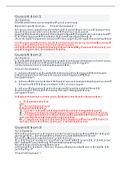
-
BIOD 171 Microbiology module5 exam Review
- Exam (elaborations) • 16 pages • 2023
-
- $9.99
- + learn more
Define the concept of universal precautions. Your Answer: this concept means that handlers must be precautious and consider the received samples as hazardous and pathogenic and use PPE ( Personal Protective Equipment) during the process of recognizing the samples Universal precautions means any and all samples, whether known or unknown, are to be treated as potentially hazardous (or pathogenic) materials. Question 2 3 / 3 pts List at least 3 observations a researcher would be sure to...
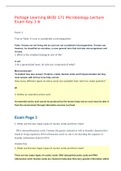
-
Portage Learning BIOD 171 Microbiology Lecture Exam Key 1-6
- Exam (elaborations) • 34 pages • 2022
-
Available in package deal
-
- $15.49
- + learn more
Portage Learning BIOD 171 Microbiology Lecture Exam Key 1-6 Exam 1. True or False: A virus is considered a microorganism. False. Viruses are not living and as such are not considered microorganisms. Viruses can, however, be classified as microbes, a more general term that includes microorganisms and viruses. 2. What is the smallest biological unit of life? A cell. 3. At a generalized level, all cells are comprised of what? Macromolecules* *A student may also answer: Proteins,...

-
Portage Learning BIOD 171 Microbiology Lecture Exam Key 1-6( 2)
- Exam (elaborations) • 34 pages • 2022
-
Available in package deal
-
- $15.49
- + learn more
Portage Learning BIOD 171 Microbiology Lecture Exam Key 1-6 Exam 1. True or False: A virus is considered a microorganism. False. Viruses are not living and as such are not considered microorganisms. Viruses can, however, be classified as microbes, a more general term that includes microorganisms and viruses. 2. What is the smallest biological unit of life? A cell. 3. At a generalized level, all cells are comprised of what? Macromolecules* *A student may also answer: Proteins,...

-
Portage Learning BIOD 171 Microbiology Lecture Exam Key 1-6
- Exam (elaborations) • 34 pages • 2022
-
- $13.99
- + learn more
Portage Learning BIOD 171 Microbiology Lecture Exam Key 1-6 Exam 1. True or False: A virus is considered a microorganism. False. Viruses are not living and as such are not considered microorganisms. Viruses can, however, be classified as microbes, a more general term that includes microorganisms and viruses. 2. What is the smallest biological unit of life? A cell. 3. At a generalized level, all cells are comprised of what? Macromolecules* *A student may also answer: Proteins,...
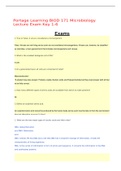
-
Portage Learning BIOD 171 Microbiology Lecture Exam Key 1-6
- Exam (elaborations) • 28 pages • 2022
-
- $14.89
- + learn more
Portage Learning BIOD 171 Microbiology Lecture Exam Key 1-6 Exams 1. What are the two major types of nucleic acids and their roles? DNA- deoxyribonucleic acid RNA- Ribonucleic acid DNA- Cellular life has DNA and a role that DNA has is long-term storage of information, it holds the characteristics of living organisms. RNA- Is the carrier of information in form of amino acid sequence. It converts the information in the DNA and synthesizes proteins Tru...
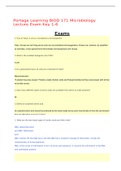
-
Portage Learning BIOD 171 Microbiology Lecture Exam Key 1-6
- Exam (elaborations) • 28 pages • 2022
-
- $14.49
- + learn more
Portage Learning BIOD 171 Microbiology Lecture Exam Key 1-6 Exams 1. What are the two major types of nucleic acids and their roles? DNA- deoxyribonucleic acid RNA- Ribonucleic acid DNA- Cellular life has DNA and a role that DNA has is long-term storage of information, it holds the characteristics of living organisms. RNA- Is the carrier of information in form of amino acid sequence. It converts the information in the DNA and synthesizes proteins Tru...
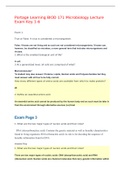
-
Portage Learning BIOD 171 Microbiology Lecture Exam Key 1-6( 2)
- Exam (elaborations) • 34 pages • 2022
-
- $14.59
- + learn more
Portage Learning BIOD 171 Microbiology Lecture Exam Key 1-6 Exam 1. True or False: A virus is considered a microorganism. False. Viruses are not living and as such are not considered microorganisms. Viruses can, however, be classified as microbes, a more general term that includes microorganisms and viruses. 2. What is the smallest biological unit of life? A cell. 3. At a generalized level, all cells are comprised of what? Macromolecules* *A student may also answer: Proteins,...
BIO 171 BIO 171 Exams|Lab Exams|lecture Exam keys 2021

-
BIOD 171
- Exam (elaborations) • 22 pages • 2021
-
- $11.00
- 1x sold
- + learn more
BIOD 171 lab exams 1-9 LAB 1 Answer the following questions 1. What three elements are used in an autoclave to sterilize equipment? heat, pressure, and steam 2. What is the minimum temperature an autoclave must be set at to achieve sterile condition? 125°C 3. If you are working in a lab in which an autoclave is not available, and you are pressed for time, which would you chose to best sterilize your equipment? Hot steam or hot air? Explain why you chose your answer. Hot ...

That summary you just bought made someone very happy. Also get paid weekly? Sell your study resources on Stuvia! Discover all about earning on Stuvia



